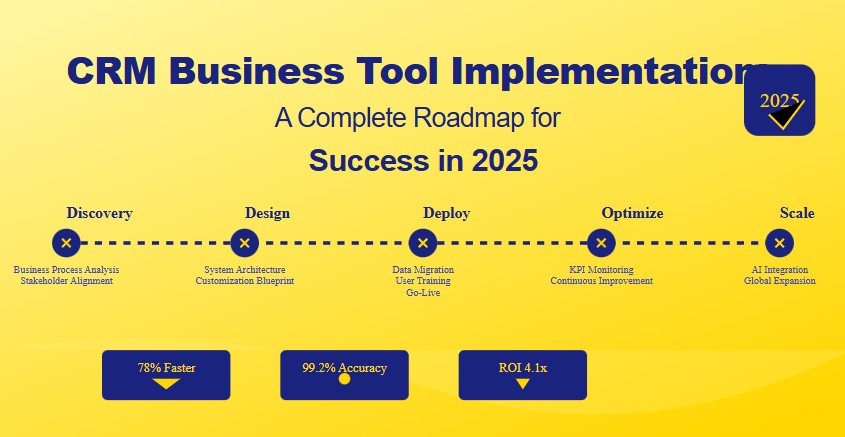In the digital-first business era, managing customer relationships efficiently is critical for survival—and growth. That’s why more companies, from startups to large enterprises, are turning to CRM business tools. But buying a CRM system is only step one. The true value comes from strategic implementation.
CRM Business Tool Implementation is the structured process of planning, configuring, integrating, and deploying a CRM system to streamline customer management, sales, marketing, and support.
In this in-depth guide, you’ll learn:
-
🔹 What CRM tool implementation involves
-
🔹 Common challenges businesses face
-
🔹 A proven step-by-step implementation plan
-
🔹 Key features and integrations to prioritize
-
🔹 Roles involved in implementation
-
🔹 Best practices to avoid failure
-
🔹 Real-world use cases
-
🔹 Tools and platforms to consider
Let’s unpack how to do CRM implementation the right way in 2025.
Table of Contents
💡 What is CRM Business Tool Implementation?
CRM (Customer Relationship Management) tool implementation refers to the end-to-end process of deploying a CRM system into your organization’s workflow.
This includes:
-
Choosing the right CRM software
-
Configuring it to your sales/marketing/service process
-
Migrating customer data
-
Training users
-
Automating tasks and setting KPIs
-
Integrating third-party tools (email, calendar, e-commerce, etc.)
“CRM implementation is not just IT—it’s transformation.”
📊 Why CRM Implementation Matters
According to Forrester Research, companies that effectively implement CRM tools improve customer retention by 27% and boost conversion rates by over 35%.
Without a proper plan, CRM projects face:
| Pitfall | Risk |
|---|---|
| ❌ Poor Adoption | Teams revert to spreadsheets or ignore the tool |
| ❌ Data Migration Errors | Lost or duplicated customer records |
| ❌ Misalignment | CRM features don’t support real business needs |
| ❌ Integration Gaps | CRM doesn’t sync with email, billing, or marketing platforms |
| ❌ Budget Overruns | Costs balloon due to poor planning or scope creep |
🔁 7-Step CRM Business Tool Implementation Framework
Below is a battle-tested roadmap to successfully implement any CRM platform.
1. Define Your Business Goals
Begin with clarity.
Ask:
-
Are we trying to track leads better?
-
Improve customer service speed?
-
Automate sales follow-ups?
-
Centralize data across departments?
🧠 Pro Tip: List out 3–5 key objectives. Your CRM configuration will be based on these.
2. Choose the Right CRM Tool
Evaluate based on:
-
Business size (Solo, SMB, Enterprise)
-
Use case (Sales, Marketing, Support, All-in-One)
-
Integration needs (e.g., Gmail, QuickBooks, Shopify)
Popular CRM tools by segment:
| Segment | Recommended CRM Tools |
|---|---|
| Freelancers/SMB | Zoho Bigin, HubSpot, Capsule CRM |
| Mid-size B2B | Pipedrive, Monday CRM, Freshsales |
| Enterprise | Salesforce, Microsoft Dynamics, Zoho CRM Enterprise |
3. Assemble Your Implementation Team
Even small businesses need defined roles:
| Role | Responsibilities |
|---|---|
| Project Manager | Oversees timeline, budget, and stakeholder alignment |
| CRM Consultant | Designs workflows, configures tools |
| IT/Admin | Handles integration, user access, and security setup |
| Department Reps | Provide real-world input on CRM use cases |
| Trainer | Prepares onboarding materials and sessions |
4. Map Your Customer Journey and Workflows
This is the blueprint stage.
You’ll need to define:
-
Lead sources (forms, emails, cold calls)
-
Sales funnel stages (Prospect → Contacted → Closed)
-
Support ticket flow
-
Email sequences and automated reminders
-
Internal task assignments (e.g., notify account manager after a deal closes)
Tools to help:
🧩 Miro, Lucidchart, Figma, Whimsical (for flowcharting)
5. Configure the CRM Tool
Customize:
-
Fields and modules (custom tags, contact info, company data)
-
Pipelines and funnels
-
Dashboard KPIs (e.g., conversion rate, churn rate, ticket resolution time)
-
Automation logic (triggers, tasks, alerts)
-
User roles and permissions
Most platforms offer drag-and-drop builders and templates. Start simple—optimize later.
6. Data Migration and Integration
Move your old data from:
-
Spreadsheets
-
Legacy CRMs
-
Marketing tools (Mailchimp, Constant Contact)
-
Support platforms (Zendesk, HelpScout)
Also connect:
-
📧 Email (Gmail, Outlook)
-
📅 Calendar (Google, Outlook)
-
🛒 E-commerce (Shopify, WooCommerce)
-
💳 Payment (Stripe, PayPal)
-
📣 Marketing (Mailchimp, ActiveCampaign)
Tip: Run a data quality check before importing.
7. Train, Launch, and Iterate
A powerful CRM is useless if no one uses it.
-
Conduct team training (live or via video)
-
Provide cheat sheets and SOPs
-
Track usage in the first 30 days
-
Collect feedback → Optimize
📈 Use built-in CRM analytics to spot friction points and user drop-off.
🛠️ Core Features Every CRM Implementation Should Include
| Feature | Purpose |
|---|---|
| Contact Management | One place for all leads, clients, vendors |
| Sales Pipeline | Visualize deals in progress |
| Automation Workflows | Save time with pre-built actions and follow-ups |
| Email Integration | Centralize communications |
| Task & Calendar Sync | Keep your team accountable and on-time |
| Analytics & Dashboards | Make decisions based on real-time data |
| Mobile Access | Enable productivity on-the-go |
🔌 Best Integrations to Connect With CRM
| Tool Type | Examples | Why Integrate? |
|---|---|---|
| Gmail, Outlook | Track email opens, log conversations | |
| Calendar | Google Calendar, Outlook | Auto-schedule follow-ups |
| E-Commerce | Shopify, WooCommerce | Import orders, track repeat customers |
| Forms | Typeform, Jotform | Capture leads directly into CRM |
| Accounting | QuickBooks, Xero | See client payment history |
| Support | Zendesk, Freshdesk | Convert tickets into CRM tasks |
📈 Real-World Use Case: CRM Implementation Success
Company: EcoLite Solar Solutions
Industry: Green Energy
Challenge: Scattered lead tracking, delayed follow-ups, no visibility on sales rep performance
Solution:
-
Implemented Pipedrive with Gmail & Google Calendar sync
-
Created automated workflows for demo scheduling
-
Designed dashboards for lead source ROI
Results:
-
2x increase in lead conversion
-
40% drop in no-show rates
-
80+ hours saved per month via automation
❌ Top 5 CRM Implementation Mistakes to Avoid
-
Skipping the Planning Phase
→ Leads to poor adoption and underused features -
Importing Dirty Data
→ Duplicates, outdated contacts = trust issues -
Over-Customizing Too Early
→ Start lean, then optimize based on user behavior -
No User Training
→ Your team won’t use what they don’t understand -
Ignoring Integration Needs
→ Leads to disconnected workflows and double entry
🧠 Final Tips for a Flawless CRM Rollout
-
🟢 Start with 1-2 workflows and expand gradually
-
🟢 Set measurable KPIs (e.g., lead-to-close time, response time)
-
🟢 Use built-in automation features before adding third-party tools
-
🟢 Appoint a CRM champion internally
-
🟢 Collect team feedback monthly for ongoing improvements
🎯 Final Thoughts: CRM Implementation is a Long-Term Asset
Successful CRM business tool implementation doesn’t end at setup — it begins there. A well-implemented CRM empowers your business to scale, serve customers better, close more deals, and stay ahead of competitors.
Remember, a CRM is only as good as the processes and people behind it.
“The goal isn’t to use CRM. It’s to create better relationships, faster sales, and smarter teams.”




